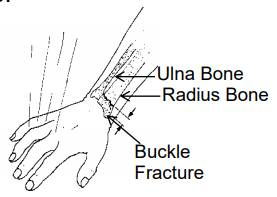Buckle Fractures of the Radius in Children
Please note, this page is printable by selecting the normal print options on your computer.
Buckle Fractures
Your child has been diagnosed with a ‘Buckle Fracture’ of the forearm. This leaflet is designed to tell you what a ‘Buckle’ Fracture is, how it is treated, and how long it will take to get better. It also tells you what to do if you’re concerned or have any questions.
Which bone is broken?
There are two bones in the forearm, the radius and the ulna. If you look at your right forearm with your palm facing you, your radius bone runs between the wrist closest to the base of the thumb and the elbow. The ulna bone runs between the little finger side of the wrist and the elbow. Your child has broken their radius bone, closer to the wrist than the elbow. Sometimes, this is called a ‘Distal Radius’ Fracture.
What is a buckle fracture?

Buckle fractures of the forearm are very common injuries in children. Children have softer bones than adults, and heavy falls can cause the bone to ‘buckle’ or bunch up on one side. This is known
as a buckle fracture. It is sometimes also called a ‘torus’ fracture or ‘incomplete’ fracture, as the bone is not broken all the way through.
What treatment will my child have?
• Your child will have been placed in a plaster or splint before leaving the hospital.
• Sometimes additional x-rays are taken, to check position.
• At home, give your child pain relieving medicines such as paracetamol, providing they’re not allergic to this.
Follow the instructions on the packet for how much to give:
• Keep the elevated in a sling for 24 hours to reduce swelling.
How long will it take to heal
Buckle fractures usually heal in 3 to 4 weeks.
Will my child need an operation?
No, not usually. If an operation is needed, we will talk to you about this in detail.
Can I send my child to school?
Yes, but they shouldn’t take part in PE (Physical Education) lessons whilst in the plaster / splint.
Is it normal to feel a lump?
Yes. You may be able to feel a lump over the fracture as it heals; this is normal and will reduce with time.
Looking after the splint/plaster
Your child will need to be in the splint or plaster for 3 to 4 weeks. Taking good care of the splint or plaster will prevent skin problems and discomfort.
Do:
• Keep the plaster/splint clean & dry
• Watch for signs of damage – call the plaster room if you think the plaster/splint is broken
• Let your child attend school & use the arm as usual, but avoid contact sports e.g. football, gym
• Keep the splint on at all times except when washing
Don’t:
• Push anything between the plaster/splint and the skin. It can cause serious injury, which may not been seen until the splint is removed.
• Get the plaster wet – it isn’t waterproof
After 3 to 4 weeks the splint/plaster can be removed. If instructed to by the doctor in clinic you may be able to do this at home without the need for another trip to fracture clinic. If so you will have a separate information leaflet on this.
What can I expect once the plaster/splint is removed?
It may be stiff at first, this will settle. Rub the skin with simple moisturiser to treat any flaky or dry skin. Your child should then use the arm as normal, but avoiding contact sports/PE for 3 weeks.
Where to go for more help / information
For questions regarding the splint or plaster or if you are concerned that your child’s fracture isn’t healing properly: Please call the plaster room (Monday-Friday 9am-5pm 01908 995185) who can arrange for your child to be seen.
In an emergency attend your nearest A&E Department, but for other concerns contact your child’s GP.
